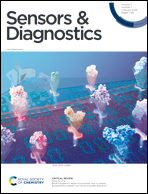Highly selective fluorescent sensor for ammonium ions†
Abstract
Ammonium ions (NH4+) are one of the important metabolic products and are closely related to human health. Currently, many NH4+ detection methods are inevitably disturbed by amino acids, K+, or other substituted amines (such as trimethylamine). To alleviate this problem, a new sensor was designed in this study, which consisted of the fluorescent indicator KS, hydrogel medium D4, and a hydrophobic membrane. In this sensing system, NH4+ and NH3 coexisted in equilibrium; NH3 could pass through a suitable hydrophobic film and transform into NH4+, which complexed with KS, resulting in a change of the probe's fluorescence intensity. By adjusting the internal composition of the sensing matrix, an excellent NH4+ sensor NS-1 was obtained; it demonstrated effective detection of NH4+ in the range 0.3–15.6 mM with a limit of detection (LOD) of 258 μM, and it was not disturbed by K+ or other substituting amines.



 Please wait while we load your content...
Please wait while we load your content...